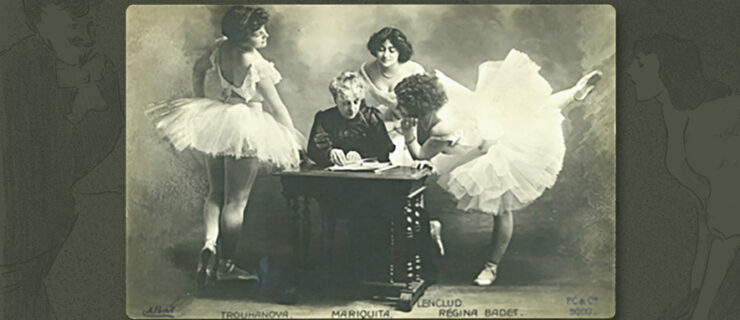Nervous for Nutcracker Auditions? Here's How to Prepare— and How to Deal When Casting Doesn't Go Your Way
Updated on 9/7/22.
The end of summer can only mean one thing in ballet world: Nutcracker audition season. It’s the time of year when everyone at your studio is on edge with excitement, nerves and dreams. It’s when you rewatch DVDs of past performances, practice choreography in your kitchen and make a list of roles you hope to get.
Nutcracker might be your only performance opportunity of the year, or the most significant one, so stakes are high. It’s understandable if you feel anxious. We spoke with former American Ballet Theatre principal and Jacqueline Kennedy Onassis School acting artistic director Stella Abrera and Joffrey Ballet dancer Lucia Connolly, who have been in your ballet shoes, as well as The School of Ballet Arizona Upper Division Coordinator and Studio Company Manager Alecia Good-Boresow for their advice on approaching this year’s Nutcracker auditions.

Stella Abrera in Alexei Ratmansky’s The Nutcracker. Rosalie O’Connor, Courtesy ABT
Prepping For Audition Day
Before the big day, take a step back and reflect on why you want to audition in the first place. “Chances are, it’s because you love to dance,” says Abrera, whose first role in her local Nutcracker was a Polichinelle. “With that in mind, it’s okay to go ahead and acknowledge what makes you nervous about auditioning, but then consider your favorite part of ballet class or your favorite steps and focus on those as you approach audition day.”
On the practical side of things, be smart about audition attire: Wear your hair in a neat bun, avoid extra layers of clothing, and always make sure your pointe shoe ribbons are secured during auditions. “The people in the front of the room will take that as a sign of being professional,” says Abrera. At the same time, pay attention to more than just how it looks. “Wear a favorite leotard that makes you feel beautiful and that feels good to dance in,” says Connolly, who performed Nutcracker growing up at Westside School of Ballet in California.
If your studio uses more or less the same choreography each year, Good-Boresow recommends finding time to work on the role you want beforehand. “The best piece of advice I can give is from Central Pennsylvania Youth Ballet’s founder Marcia Dale Weary, and it’s simply practice. Know the part you’re aiming to get inside out and backwards.” Doing so, she says, will allow you to relax, get into character and find freedom to perform during the audition.

Lucia Connolly and Luis Eduardo Gonzalez in The Nutcracker. Cheryl Mann, Courtesy The Joffrey Ballet
Handling Nerves and Performing Your Best
When the big day arrives, try to avoid comparing yourself to your classmates—easier said than done, of course. “You can be aware of others in the audition, but if you focus on them, you can psych yourself out,” says Abrera. “It doesn’t matter what the person next to you is doing—find your own motivation without comparison, dance for your own desire.” This hearkens back to her earlier advice: to put your heart and energy into your favorite aspects of ballet class—whether that’s pirouettes and grand allégro, port de bras and adagio, tackling challenging combinations, or just the feeling of moving across space. “If you focus on what gives you joy, you will bring that joy to your movement quality,” she says.
Keep in mind that all of the classes you’ve taken and the corrections you’ve applied throughout your lifetime have prepared you for this day. Lean into your training, says Connolly. “Remember that your body knows how to do the steps,” she says.
Sometimes, just knowing that someone else has confidence in you can keep you from feeling overwhelmed. If you know an encouraging teacher, friend or family member who can give you some words of reassurance, let them know that you’re nervous about auditioning. “Sometimes, just hearing ‘I believe in you’ can make all the difference,” says Good-Boresow.

Connolly performs as a Polichinelle in her hometown studio’s production of The Nutcracker. Courtesy Connolly
Dealing With Casting Disappointments
What happens if your dreams of getting cast as Sugar Plum don’t come true? “Step one is to process everything, to feel everything you’re going to feel,” says Abrera. “You don’t have to sweep your emotions under the rug—after all, you’ve worked hard trying to get this role.” The next step is to try to change your perspective. “Ask yourself what you can learn from the experience,” she says. “Nothing that happened in that audition goes to waste.” Finally, channel your emotions and efforts into the part you did receive. “Make the role your own,” says Abrera. “Give it 110 percent. You will find fulfilment.”
Remember that casting results often have nothing to do with how you performed in an audition. “It could just be that you’re not the right height for the costume and the studio doesn’t have the budget to make new costumes this year,” says Good-Boresow.
Connolly believes that dealing with Nutcracker casting letdowns is good practice for a professional career. “If you want to be part of the ballet world, getting used to casting disappointments is part of the process,” she says. She also feels it’s a great opportunity to work on self-growth. “If your friends are cast in the roles that you wanted, it’s essential to make an effort to be happy for them,” she says. “It’s worth the investment. Your relationships with your friends and colleagues are more valuable than any particular role.”
As you move forward, don’t forget that the experience of being in Nutcracker goes beyond dance. “It’s such a wonderful tradition and a wonderful time of year,” says Abrera. “Allow yourself to enjoy the time you spend with your friends and family, making bonds and making memories—you’ll always have those to carry with you.”





